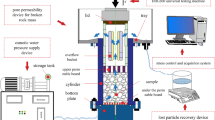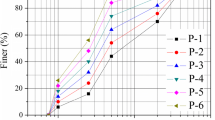Abstract
Water inrush disasters originating from completely weathered granite are strongly affected by its physical and mechanical properties, such as the porosity, permeability, and water stability. The porosity and permeability are heavily affected by the particle composition. Meanwhile, a large amount of particles with poor cementation, are transferred by water, which may affect the flow properties and water inrush. This study investigates the mass transfer and flow properties of water inrush in completely weathered granite for different particle size distributions. To this end, a series of tests was performed by designing a new testing system, which can induce mass transfer and apply external pressures during the tests. The results demonstrate the following: (1) the flow properties and water inrush are related to the mass transfer. In the experiments, it was found that the permeability of the samples increases by a factor of 14–53.3, compared with the initial permeability. Thus, a notable signal to forecast water inrush can be obtained, which represents the change in water quality from muddy water to clear water. (2) With an increase in Talbot index n, the mass transfer and porosity first decrease and then increase. However, the permeability and water inflow increase and a critical value of n = 1.0 is required to induce the water inrush. (3) Three flow stages, namely, a Darcy flow, rapid flow, and stable flow, can be utilized to describe the water inrush evolution. Non-Darcy flow properties and high water inrush risk are observed in the second stage, where the water inflow increases to 551 mL/min, which is more than thrice that in the Darcy flow for n = 1.0. The obtained results can provide an important reference to understand the mechanisms, forecast the risks, and implement effective control measures for water inrush (e.g., optimum control time).
















Similar content being viewed by others
Abbreviations
- a:
-
Sample radius (L)
- c:
-
Fluidized grain concentration
- d:
-
Current particle diameter (L)
- \({D_l}\) :
-
Maximum particle diameter (L)
- \({d_p}\) :
-
Limit diameter corresponding to the weight of 10% (L)
- h :
-
Sample height (L)
- k :
-
Permeability (L2)
- k′:
-
Permeability increase rate (L2 T−1)
- \({k_0}\) :
-
Initial permeability (L2)
- \({k_f}\) :
-
Ultimate permeability (L2)
- l:
-
Permeability path length (L)
- m (0−0.25mm), m (0.25−2mm), m (2−3mm), m (3−5mm), m (5−10mm) :
-
Particle mass related to particle size (M)
- \({m_{\text{t}}}\) :
-
Sample total mass (M)
- \({m_{\text{u}}}\) :
-
Ultimate transfer mass (M)
- n :
-
Talbot index
- p :
-
Pore pressure (M L−1 T−2)
- \({p_1}\) :
-
Pore pressure connected with atmosphere (M L−1 T−2)
- p 2 :
-
Pore pressure at the inlet boundary (M L−1 T−2)
- \({P_l}\) :
-
The percent by weight finer than particle size “d”
- Q :
-
Water inflow (L3 T−1)
- Re :
-
Reynolds number
- t :
-
Time (T)
- v :
-
Water flow velocity (L3 T−1)
- z :
-
Vertical coordinate through the center of the sample (L)
- φ :
-
Porosity
- φ 0 :
-
Initial porosity
- β :
-
Non-Darcy flow coefficient (L−1)
- µ :
-
Kinetic viscosity (M L−1 T−1)
- π :
-
Circumference ratio
- ρ :
-
Fluid density (M L−3)
- \(\partial\) :
-
Partial differential operator
- \(\Delta\) :
-
Delta operator
- \(\nabla\) :
-
Nabla operator (L−1) \(\nabla ()=\frac{{\partial ()}}{{\partial Z}}\)
- i, z :
-
Spatial indices
References
Arıkan F, Ulusay R, Aydın N (2007) Characterization of weathered acidic volcanic rocks and a weathering classification based on a rating system. Bull Eng Geol Environ 66:415–430
Ceryan S, Tudes S, Ceryan N (2008) A new quantitative weathering classification for igneous rocks. Environ Geol 55:1319–1336
Cui QL, Wu HN, Shen SL, Yin ZY, Horpibulsuk S (2016) Protection of neighbour buildings due to construction of shield tunnel in mixed ground with sand over weathered granite. Environ Earth Sci 75:1–11
Erhard P, Etling D, Muller U, Riedel U, Sreenivasan KR, Warnatz J (2009) Prandtl-essentials of fluid mechanics, 3rd edn. Springer Science & Business Media, New York
Fiès JC (1992) Analysis of soil textural porosity relative to skeleton particle size, using mercury porosimetry. Soil Sci Soc Am J 56:1062–1067
Forchheimer P (1901) Wasserbewegung durch Boden. Z Ver Deutsch Ing 45:1782–1788
Gamon TI (1983) A comparison of existing schemes for the engineering description and classification of weathered rocks in hong kong. Bull Int Assoc Eng Geol 28:225–232
Guo WJ, Liu YX (1989) The concept of water in-rush coefficient and its application. J Hebei Coal 2:56–60
Irfan TY (1996) Mineralogy, fabric properties and classification of weathered granites in Hong Kong. Q J Eng Geol Hydrogen 29:5–35
Kong XY (2010) Advanced mechanics of fluids in porous media, 2nd edn. Press of University of Science and Technology of China, Hefei
Li L, Tu W, Shi S, Chen J, Zhang Y (2016) Mechanism of water inrush in tunnel construction in karst area. Geomat Nat Haz Risk 7:1–12
Liu D, Cha K, Li QB (2005) Prediction of water inflow into qinling extra-long tunnel on no. 1 line based on fuzzy analogy. Mod Tunn Technol 3:46–48, 53
Liu W, Fei X, Fang J (2012) Rules for confidence intervals of permeability coefficients for water flow in over-broken rock mass. Int J Min Sci Technol 22:29–33
Liu XX, Xu YS, Cheng WC, Shen SL, Horpibulsuk S (2016) Investigation of hydraulic parameters of a weathered mylonite fault from field pumping tests: a case study. Bull Eng Geol Environ 76:1431–1448
Liu J, Chen W, Yuan J, Li C, Zhang Q, Li X (2018a) Groundwater control and curtain grouting for tunnel construction in completely weathered granite. Bull Eng Geol Environ 77(2):515–531
Liu J, Chen W, Yang D, Yuan J, Li X, Zhang Q (2018b) Nonlinear seepage–erosion coupled water inrush model for completely weathered granite. Mar Georesour Geotechnol 36:484–493
Lumb P (1962) The properties of decomposed granite. Geotechnique 12(3):226–243
Ma D (2012) Boundary integral computation of elastic water resisting key strata under the condition of discontinuous load. Comput Model Eng Sci 83:561–574
Ma D, Miao XX, Chen ZQ, Mao XB (2013) Experimental investigation of seepage properties of fractured rocks under different confining pressures. Rock Mech Rock Eng 46:1135–1144
Ma D, Miao XX, Jiang GH, Bai HB, Chen ZQ (2014) An experimental investigation of permeability measurement of water flow in crushed rocks. Transp Porous Med 105:571–595
Ma D, Miao X, Bai H, Pu H, Chen Z, Liu J, Huang Y, Zhang G, Zhang Q (2016) Impact of particle transfer on flow properties of crushed mudstones. Environ Earth Sci 75:593
Niebling MJ, Toussaint R, Flekkøy EG, Måløy KJ (2012) Dynamic aerofracture of dense granular packings. Phys Rev E Stat Nonlin Soft Matter Phys 86:61315. https://doi.org/10.1103/PhysRevE.86.061315
Oslash J, Chevalier C, Lindner A, Toussaint R, Cl Eacute E, Ment M, Aring KJ, Oslash L (2008) Decompaction and fluidization of a saturated and confined granular medium by injection of a viscous liquid or gas. Phys Rev E Stat Nonlinear Soft Matter Phys 78:51302
Shirlaw JN (2016) Pressurised tbm tunnelling in mixed face conditions resulting from tropical weathering of igneous rock. Tunn Undergr Space Technol 57:225–240
Shirlaw JN, Hencher SR, Zhao J (2000) Design and construction issues for excavation and tunnelling in some tropically weathered rocks and soils. In: ISRM international symposium. International Society for Rock Mechanics
Talbot AN, Richart FE (1923) The strength of concrete, its relation to the cement aggregates and water. Illinois Univ Eng Exp Sta Bulletin 137
Tang CA, Tham LG, Lee PKK, Yang TH, Li LC (2002) Coupled analysis of flow, stress and damage (FSD) in rock failure. Int J Rock Mech Min 39:477–489
Wang JA, Park HD (2003) Coal mining above a confined aquifer. Int J Rock Mech Min 40:537–551
Wang LZ, Kong HL, Xu B, Yin Y (2016) Nonlinear seepage property of broken mudstone with particle migration. Electron J Geotech Eng 21(20):7033–7044
Wu Q, Liu YZ, Liu DH, Zhou WF (2011) Prediction of floor water inrush: the application of GIS-based AHP vulnerable index method to donghuantuo coal mine, china. Rock Mech Rock Eng 44:591–600
Yan ZL, Wang JJ, Chai HJ (2010) Influence of water level fluctuation on phreatic line in silty soil model slope. Eng Geol 113:90–98
Yang T, Tang C, Liu H (2003) Numerical model of the instability-failure process of the coal-bed floor due to confined water inrush. Journal of Geomechanics 9:281–288
Yang TH, Liu J, Zhu WC, Elsworth D, Tham LG (2007) A coupled flow-stress-damage model for groundwater outbursts from an underlying aquifer into mining excavations. Int J Rock Mech Min 44:87–97
Yang T, Chen S, Zhu W, Meng Z, Gao Y (2008) Water inrush mechanism in mines and nonlinear flow model for fractured rocks. Chin J Rock Mech Eng 27:1411–1416
Zhang HQ, He YN, Tang CA, Ahmad B, Han LJ (2009) Application of an improved flow-stress-damage model to the criticality assessment of water inrush in a mine: a case study. Rock Mech Rock Eng 42(6):911–930
Zhang R, Jiang Z, Zhou H, Yang C, Xiao S (2014) Groundwater outbursts from faults above a confined aquifer in the coal mining. Nat Hazards 71:1861–1872
Zhao P, Shao MA, Omran W, Amer AM (2011) Effects of erosion and deposition on particle size distribution of deposited farmland soils on the Chinese loess plateau. Revista Brasileira De Ciência Do Solo 35:2135–2144
Zhou YX (2015) The control of sand-guishing and water-bursting of water-rich tunnel. Railw Stand Des 6:96–102
Acknowledgements
This work was supported by the China National Natural Science Foundation of Youth Fund Project (nos. 51809253, 51708220), and the China National Basic Research Program, the “973 Program” (no. 2013CB036006).
Author information
Authors and Affiliations
Corresponding author
Additional information
Publisher’s Note
Springer Nature remains neutral with regard to jurisdictional claims in published maps and institutional affiliations.
Rights and permissions
About this article
Cite this article
Liu, J., Chen, W., Nie, W. et al. Experimental Research on the Mass Transfer and Flow Properties of Water Inrush in Completely Weathered Granite Under Different Particle Size Distributions. Rock Mech Rock Eng 52, 2141–2153 (2019). https://doi.org/10.1007/s00603-018-1719-3
Received:
Accepted:
Published:
Issue Date:
DOI: https://doi.org/10.1007/s00603-018-1719-3




